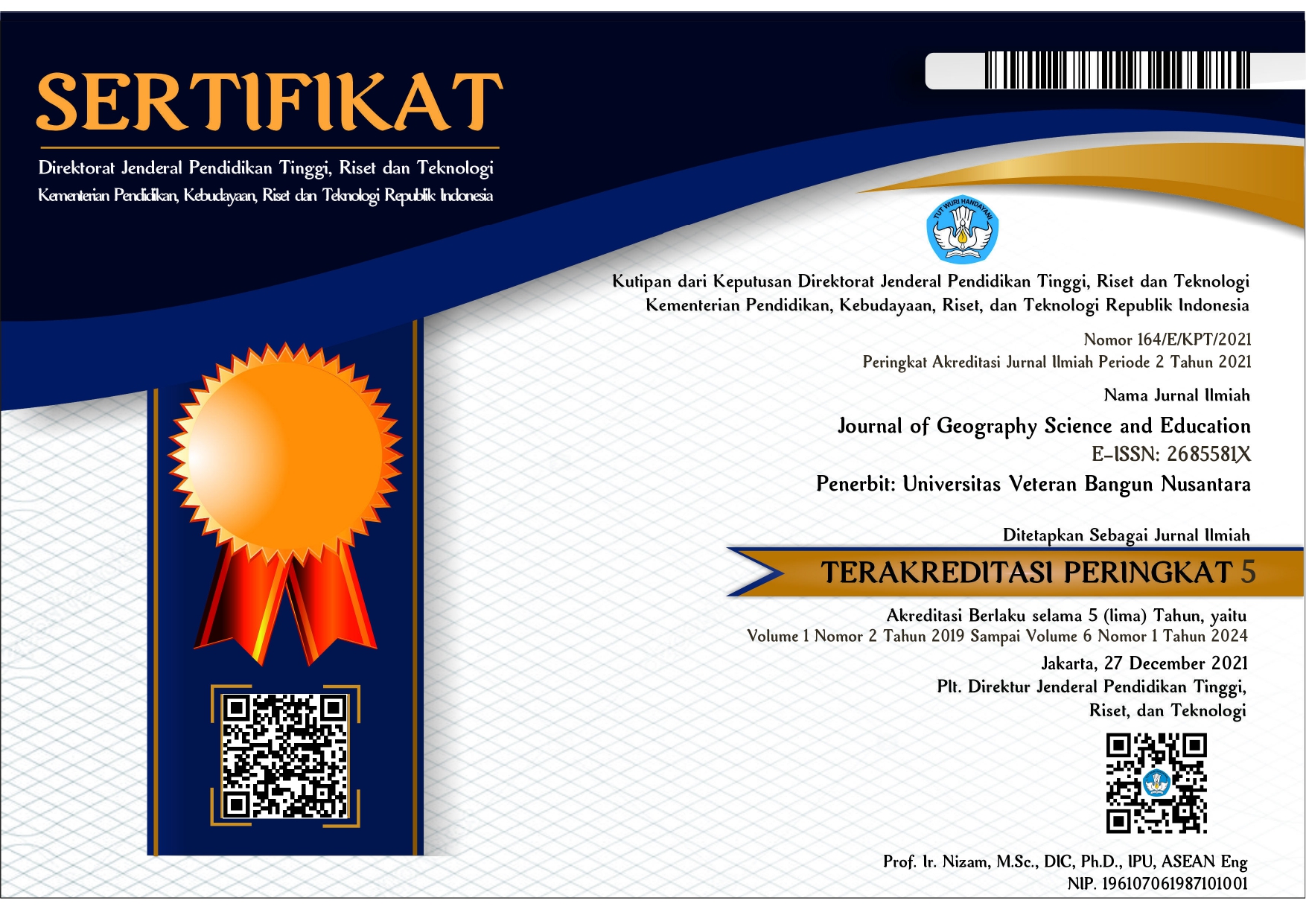DENSITY OF BUILDINGS IN GROGOL DISTRICT SUKOHARJO DISTRICT 2018
DOI:
https://doi.org/10.32585/jgse.v3i1.1514Keywords:
Remote Sensing, Visual Interpretation, Building DensityAbstract
The objectives of this study were to: (1) determine the number of buildings in Grogol District, Sukoharjo Regency; (2) anlaysis the building density in Grogol District, Sukoharjo Regency. This study uses remote sensing with the Visual Quickbird interpretation method obtained from Google Earth Pro, namely using interpretive elements such as hue / color, shape, texture, and location / association. Visual interpretation is used to determine the number of buildings and building density. The data collection techniques used were image interpretation and field surveys. The data analysis technique used is geographic descriptive, which describes the spatial data analysis. The results of this study were Cemani Village is the village with the highest density of buildings 96.85%, while Parangjoro is the village with the lowest density of buildings with 28.41%.
Downloads
References
Abdi Sukmono, 2019. Utilization of Landsat Image Hybrid Interpretation In Identification of Building Density for Development Monitoring Ungaran City Area
BPS. 2018. Grogol District in Figures of 2019. Sukoharjo
Mirta Indriastuti, Hani'ah, Abdi Sukmono, 2018. Density Analysis Building Using Hybrid Interpretation of Landsat Satellite Images in East Ungaran and West Ungaran Districts, Semarang Regency 2009-2018. Diponegoro University, Faculty of Engineering
Ratnasari, Dwi Santy, Suharyadi. 2016. Utilization of High Resolution Images Multitemporal for Analysis of Settlement Development Characteristics Bogor City, 2005-2014 Using Spatial Statistics. University Gajah Mada Yogyakarta
Shanti Puspitasari, Suharyadi. 2015. Building Density Study Using a Landsat-8 Oil Hybrid Image Interpretation in Semarang City
Suharyadi. 2011.. Hybrid Interpretation of Spatial Resolution Satellite Images Intermediate for Urban Area Building Density Study in Yogyakarta Urban Area. Gadjah Mada University Yogyakarta
Sunarhadi, MA, Utaya, S., Astina, IK., Budijanto. Learning Media Spatial Thinking: A teaching guide, media, and learning modules geography to develop participants' spatial thinking skills students. — Ed. 1, Cet. 1--, Sukoharjo: Geoinfolit, June 2018
Sutanto. 1986. Remote Sensing Volume 1. Gajah Mada University Yogyakarta
Sutanto. 1992. Remote Sensing. Gajah Mada University Yogyakarta
Downloads
Published
How to Cite
Issue
Section
License
Authors who publish with the Journal of Geography Science and Education agree to the following terms:
- Authors retain copyright and grant the journal the right of first publication with the work simultaneously licensed under a Creative Commons Attribution License (CC BY-SA 4.0) that allows others to share the work with an acknowledgment of the work's authorship and initial publication in this journal.
- Authors are able to enter into separate, additional contractual arrangements for the non-exclusive distribution of the journal's published version of the work (e.g., post it to an institutional repository or publish it in a book), with an acknowledgment of its initial publication in this journal.
- Authors are permitted and encouraged to post their work online (e.g., in institutional repositories or on their website) prior to and during the submission process, as it can lead to productive exchanges, as well as earlier and greater citation of published work.










